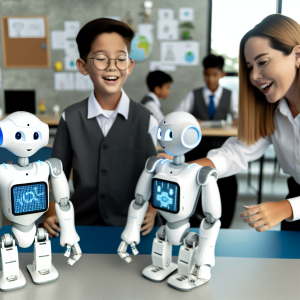-
- Transforming Child Education: The Power of AI Educational Robots in Interactive Learning
- The Importance of AI Educational Robots in Learning
- Configuration Steps for Implementing AI Educational Robots
- Step 1: Identify Educational Goals
- Step 2: Select the Right Robot
- Step 3: Set Up the Learning Environment
- Step 4: Train Educators
- Step 5: Monitor and Evaluate
- Practical Examples of AI Educational Robots in Action
- Example 1: NAO Robot in Language Learning
- Example 2: LEGO Mindstorms in STEM Education
- Best Practices for Using AI Educational Robots
- Case Studies and Statistics
- Conclusion
Transforming Child Education: The Power of AI Educational Robots in Interactive Learning
In an era where technology permeates every aspect of our lives, the education sector is undergoing a significant transformation. The integration of Artificial Intelligence (AI) and robotics into educational settings is revolutionizing how children learn, engage, and interact with information. AI educational robots are not just tools; they are interactive companions that can enhance learning experiences, foster creativity, and develop critical thinking skills. This guide explores the configuration, practical applications, best practices, and real-world impact of AI educational robots in child education.
The Importance of AI Educational Robots in Learning
AI educational robots offer a unique blend of technology and pedagogy, making learning more engaging and effective. They can adapt to individual learning styles, provide instant feedback, and create immersive learning environments. The relevance of this technology is underscored by the increasing demand for personalized education solutions that cater to diverse learning needs.
Configuration Steps for Implementing AI Educational Robots
To successfully integrate AI educational robots into a learning environment, follow these actionable steps:
Step 1: Identify Educational Goals
- Determine the specific learning outcomes you wish to achieve.
- Align the use of robots with curriculum standards.
Step 2: Select the Right Robot
- Research various AI educational robots available in the market.
- Consider factors such as age appropriateness, features, and compatibility with existing technology.
Step 3: Set Up the Learning Environment
- Prepare a dedicated space for robot interaction, ensuring it is safe and conducive to learning.
- Ensure reliable internet connectivity and access to necessary software.
Step 4: Train Educators
- Provide training sessions for teachers on how to effectively use the robots.
- Encourage educators to explore creative ways to integrate robots into their teaching methods.
Step 5: Monitor and Evaluate
- Collect data on student engagement and learning outcomes.
- Adjust the implementation strategy based on feedback and performance metrics.
Practical Examples of AI Educational Robots in Action
Several educational institutions have successfully implemented AI robots to enhance learning experiences:
Example 1: NAO Robot in Language Learning
The NAO robot, developed by SoftBank Robotics, has been used in language learning programs. It engages students in conversation, helping them practice pronunciation and vocabulary in a fun, interactive manner. Schools report increased student motivation and improved language skills.
Example 2: LEGO Mindstorms in STEM Education
LEGO Mindstorms kits allow students to build and program their robots. This hands-on approach fosters interest in STEM (Science, Technology, Engineering, and Mathematics) fields, encouraging problem-solving and critical thinking. Schools using Mindstorms have seen a rise in student participation in STEM-related activities.
Best Practices for Using AI Educational Robots
To maximize the effectiveness of AI educational robots, consider the following best practices:
- Integrate robots into existing curricula rather than using them as standalone tools.
- Encourage collaboration among students during robot interactions to promote teamwork.
- Regularly update software and hardware to ensure optimal performance.
- Gather feedback from students and educators to continuously improve the learning experience.
Case Studies and Statistics
Research indicates that the use of AI educational robots can significantly enhance learning outcomes:
- A study by the University of Southern California found that students using AI robots showed a 30% improvement in engagement levels compared to traditional teaching methods.
- According to a report by the International Society for Technology in Education (ISTE), 85% of educators who implemented AI robots reported increased student collaboration and communication skills.
Conclusion
The integration of AI educational robots into child education represents a transformative shift towards interactive and personalized learning. By following the outlined configuration steps, leveraging practical examples, and adhering to best practices, educators can create enriching learning environments that cater to the diverse needs of students. As technology continues to evolve, embracing AI educational robots will not only enhance educational outcomes but also prepare children for a future where technology and learning are intricately linked.
